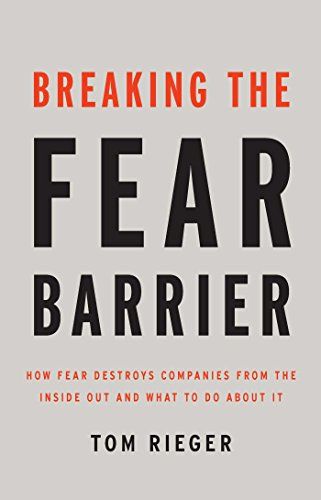Breaking the Fear Barrier – Tom Rieger

“Breaking the Fear Barrier” was published in 2011 and explores the concept of fear and how it can hold individuals and organizations back from achieving their goals. The book provides practical advice on how to overcome fear and take action toward success.
Fear is a natural human emotion, and it can either motivate or paralyze us
The first key takeaway from the book is that fear is a normal and necessary part of life. However, if we let fear control us, it can prevent us from achieving our goals and living fulfilling lives. By recognizing our fears and learning to manage them, we can harness their power to motivate us to take action.
Fear can be contagious, but so can courage
Fear can spread quickly in groups, but so can courage. By modeling courage and encouraging others to face their fears, we can create a culture of bravery and inspire others to take action.
Overcoming fear requires self-awareness and self-compassion
To overcome our fears, we must first recognize and accept them. This requires self-awareness and self-compassion, as well as a willingness to learn and grow from our experiences.
Taking action is the most effective way to overcome fear
Ultimately, the best way to overcome fear is to take action. By facing our fears head-on and taking small, incremental steps toward our goals, we can build momentum and overcome even the most daunting challenges.
Fear is often rooted in our beliefs and assumptions
Our beliefs and assumptions can shape our perceptions of reality and influence our fears. By questioning these beliefs and challenging our assumptions, we can gain a more accurate and empowering perspective.
The fear of failure is often worse than failure itself
Many people are held back by the fear of failing, but the reality is that failure is a natural part of the learning process. By reframing failure as an opportunity to learn and grow, we can overcome our fear of it and take more risks.
Mental and physical preparation can help us overcome fear
By preparing ourselves mentally and physically, we can increase our confidence and reduce our anxiety in challenging situations. This might include visualization, meditation, deep breathing, or physical exercise.
Perfectionism can be a form of fear
Many people are held back by the belief that they must be perfect, but this can be a form of fear. By accepting that we are human and embracing imperfection, we can free ourselves from the paralyzing grip of perfectionism.
Courage is not the absence of fear; it’s the willingness to act in spite of fear
This key takeaway emphasizes that courage is not the absence of fear but rather the ability to take action in the face of fear. By acknowledging our fears and taking action anyway, we can build courage and resilience.
Focusing on worst-case scenarios can amplify our fears
When we obsess over worst-case scenarios, we can make our fears seem more intense and insurmountable. Instead, we should focus on realistic outcomes and develop contingency plans to address any challenges that may arise.

